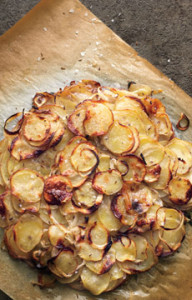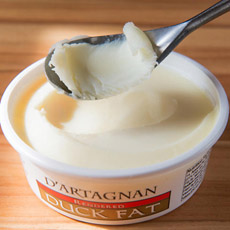|
Duck fat has long been a staple in the kitchens of top chefs. Like bacon fat, duck fat enhances the flavor of anything it touches.
One of the finest animal fats for cooking, it actually is low in saturated fat. As an ingredient, it has a silky mouth feel, subtle flavor and a high smoke point, which makes it valuable for high-heat cooking like French fries or pan searing.
Other benefits include deep browning and the ability to re-use the fat after cooking with it (strain it into a container).
DUCK FAT WITHOUT GUILT
Recent studies on duck fat show that it is low in saturated fat and high in unsaturated fat, making it one of healthiest animal fats you can eat.
Duck fat contains only 33% saturated fat; 62% is unsaturated fat (13.7% of which is polyunsaturated fat, containing Omega-6 and Omega-3 essential oils).
Duck fat is closer nutritionally to olive oil, with 75% monounsaturated fat, 13% saturated fat, 10% omega-6 linoleic acid and 2% omega-3 linoleic acid, than it is to other animal fats.
It’s high in oleic acid, a monounsaturated fat that actually helps keep cholesterol numbers in check (it’s the same fat that makes olive oil heart-healthy).
Most of the saturated fat is stearic acid, which is generally considered to be heart friendly.
|
|

TOP PHOTO: Duck Fat-Potato Galette with Caraway and Sweet Onions from Bon Appetit. Here’s the recipe. BOTTOM PHOTO: A French classic: confit leg of duck in cassoulet, with duck bacon. Photo courtesy Payard | NYC. |
|
Duck fat has less saturated fat than butter, (which has 51%).
High use of duck fat equals lower heart disease. In the southwest of France, where duck is the go-to cooking fat, the incidence of cardiovascular disease is about half that of the rest of France—which, per the French paradox, is already less than half that of the U.S.
While the USDA may never declare duck fat to be heart-healthy like olive oil, you can use it without guilt. You have plenty of time to try it: It keeps frozen for six months or longer.
HOW TO USE DUCK FAT
Use duck fat as you would any other animal fat, in the same quantity and manner (melted vs. solid, cold vs. room temperature, for example) as the fat you’re replacing.
In place of a stick of butter, use a half cup of duck fat.
For a drizzle of oil, use a drizzle of slightly warmed duck fat.
When using duck fat for deep frying, gently melt the solid fat over medium-high heat until it completely liquefies; then raise the temperature to high to bring the fat up to the proper frying temperature.
Use Duck Fat At Breakfast
Eggs: fried or scrambled eggs, omelets, frittatas, etc. cooked in duck fat.
Potatoes: hash browns cooked in duck fat.
Use Duck Fat At Lunch & Dinner
Biscuits and popovers.
Classic French dishes such as cassoulet, confit de canard and rillettes.
Potatoes: French fries, galettes and roasted potatoes will be even crisper. Use it instead of butter in mashed potatoes.
Poultry: Instead of rubbing the bird with butter or oil before roasting, use duck fat for crisper skin. Rub some softened duck fat under the skin of the breasts and inside the cavity; massage it into the skin; then seasoning and roast in a hot oven.
Salad dressing: Substitute heated (liquid) duck fat for the oil, and pair with a fruity vinegar. Serve immediately after tossing with greens.
Searing: Give fish and seafood, meats and poultry, fish and shellfish an evenly browned, flavorful crust.
Vegetables: Sautéed or roasted, a little duck fat goes a long way in adding richness and facilitating caramelization.
Savory pie crusts: pot pie and quiche.
|





